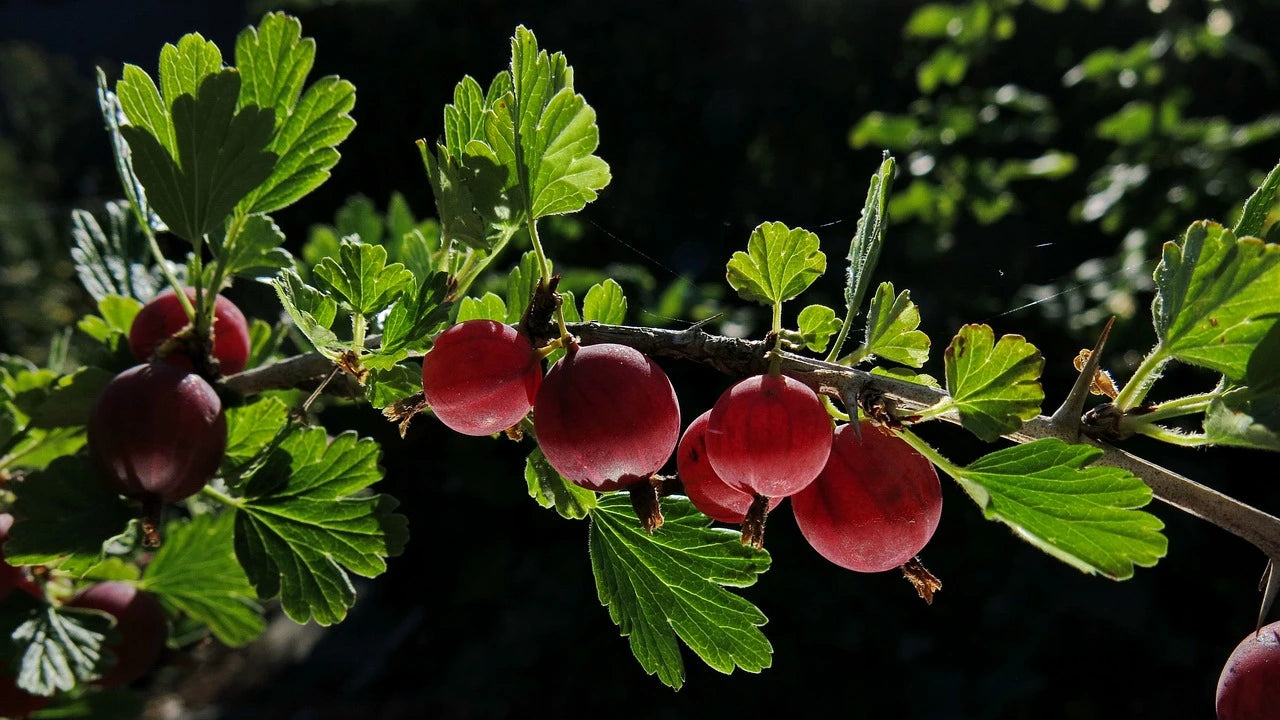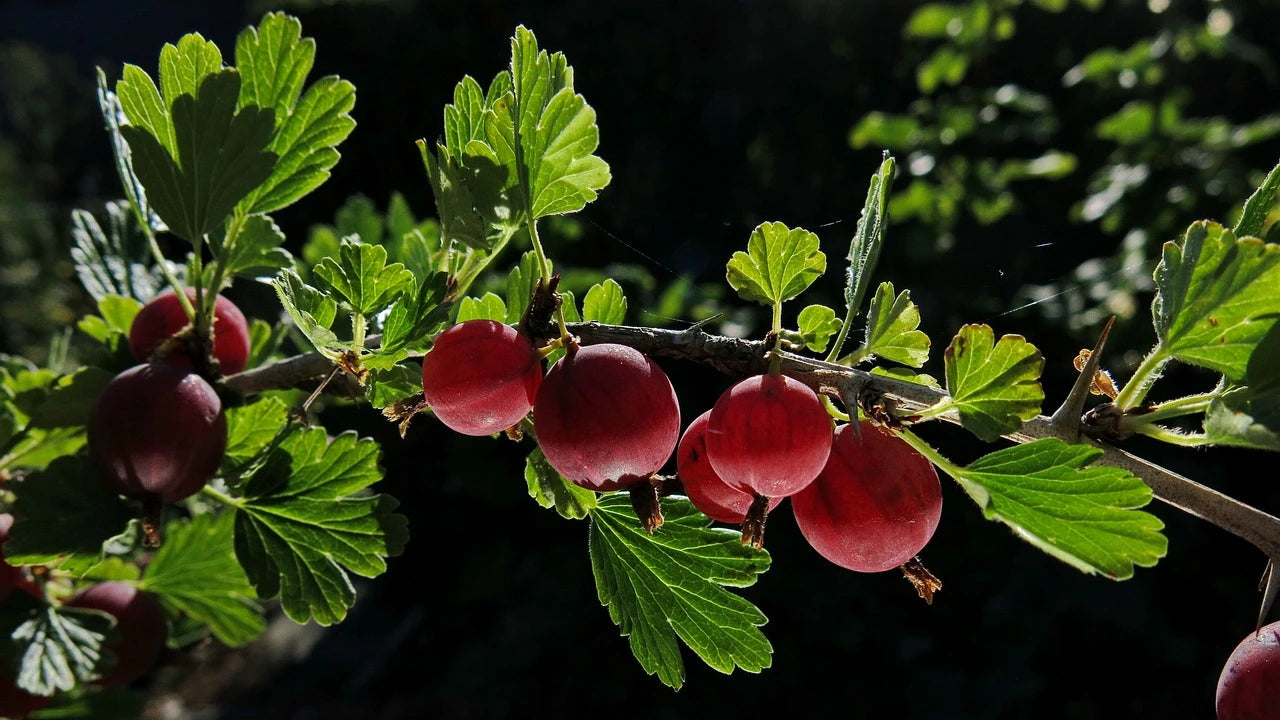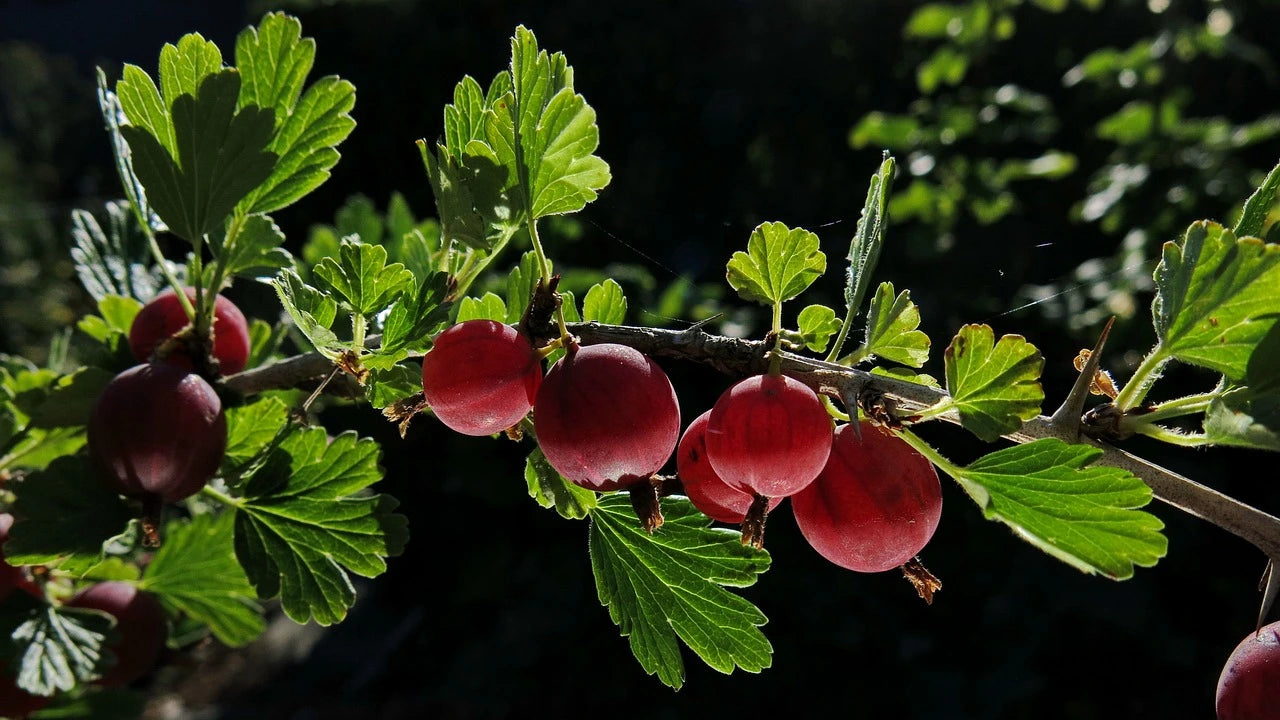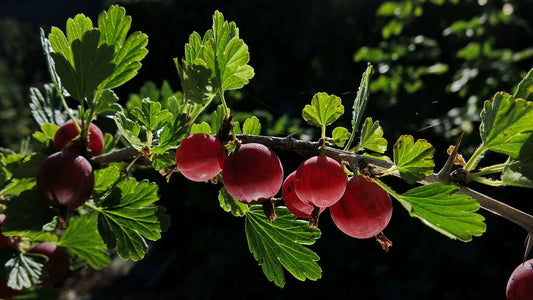-
Delivery from 10 plants within 15 days FR/ EU / CH
Delivery Terms -
Wholesale Supplier of Small Fruit Plants
About Us -
Quality Small Fruit Plants
Technical itinerary for small fruits -
Secure payment
Our Payment Terms
Whinham's Industry bare-root gooseberry plant 2 branches
Whinham's Industry bare-root gooseberry plant 2 branches
Price € excluding VAT per unit excluding transport. Our prices are based on volume. We offer you the best option based on your needs.
Couldn't load pickup availability
 Buy now and get it delivered when you're ready to plant - Add your desired date to your quote request
Buy now and get it delivered when you're ready to plant - Add your desired date to your quote request
 Delivery from 10 plants within 15 days FR/ EU / CH
Delivery from 10 plants within 15 days FR/ EU / CH
This small fruit plant is a bare-root plant
It grows as well as a small fruit plant in a pot but does not store well because it does not have a root ball to store water and nutrients. Plant quickly upon receipt. Bare-root small fruit plants represent the best compromise between cost and quality.
Ces plants de petits fruits pour professionnels sont Conventionnels
Ils ne sont pas bio. Acheter des plants de petits fruits professionnels conventionnels vous permet de produire en conventionnel. Ils ne peuvent pas être vendus en bio
When to Plant / When to Harvest Gooseberry Bushes?
Do you want to grow gooseberries but don't know when to plant them? Do you want to know when you'll harvest them? Check out our Gooseberry Planting and Harvesting Calendar
View full details
Whinham's Industry quality gooseberry bush for professional market gardeners
Whinham's Industry Gooseberry Variety Fact Sheet with Dark Red to Purple Fruits
Whinham's Industry Gooseberry Plant
- Plant earliness: Mid-Early
- Remontant / Non-remontant: Non-remontant
- Self-fertile / Self-sterile (male / female): Self-fertile variety
- Disease resistance / Hardiness / Storage: Variety slightly susceptible to mildew, sensitive to drought
- Whinham's Industry Gooseberry Productivity: High yield, up to 4KG per plant at maturity
- Origin of the variety: -
Whinham's Industry Gooseberry Bush
- Fruiting Period / Harvest Period: End of June to Mid-July
- Fruit size and shape: Large, elongated fruits
- Fruit Color: Dark red to purple
- Fruit taste and commercial use: Very tasty, fresh, slightly sweet. Widely used in processing for jam, jelly or as an accompaniment to fish or meat.
Whinham's Industry Gooseberry Bush
Whinham's Industry Gooseberry Features
Whinham's Industry Gooseberry is an exceptional variety for professional market gardeners seeking high productivity and good fruit quality. This non-everbearing variety produces large fruits and is known for its high production. It is slightly susceptible to mildew and drought, requiring special care when growing it.
Whinham's Industry Gooseberry Productivity
Whinham's Industry is renowned for its high yield, producing up to 4 kg of fruit per vine at maturity. The fruits are large and elongated, providing a bountiful harvest ideal for fresh consumption or for processing into jams, jellies, and other by-products.
Gooseberry Fruiting Period Whinham's Industry
The fruiting period of the Whinham's Industry Gooseberry extends from late June to mid-July, allowing fresh fruit to be available in early summer, thus meeting the needs of seasonal markets.
Description of Gooseberry Fruits Whinham's Industry
The fruits of the Whinham's Industry variety are dark red to purple in color, with juicy berries and a very tasty, slightly sweet flavor. Their taste is particularly pleasant, making them ideal for direct consumption, but they are also suitable for processing into jams, jellies, and as an accompaniment to fish or meat dishes. These fruits are highly valued for their refreshing flavor and pleasant texture.
Origin and Growing Tips for Gooseberry Whinham's Industry
For optimal growth, it is recommended to plant young plants in well-drained soil and ensure good sunlight. Since this gooseberry is self-fertile, it does not require a pollinator to produce fruit, making it easier for market gardeners to grow. However, it is important to monitor weather conditions to avoid mildew infections and periods of drought.
Whinham's Industry Gooseberry Earliness
In terms of earliness, the Whinham's Industry Gooseberry is classified as a mid-early variety. This means that it begins to bear fruit relatively early in the season, allowing market gardeners to benefit from its harvest quickly.
Why Buying Whinham's Industry Gooseberry Plants is a Strategic Decision for Market Gardeners
Buying Whinham's Industry Gooseberry plants is a smart decision for market gardeners looking to combine productivity and quality. With yields of up to 4 kg per plant, this mid-early variety produces large red to purple fruits, perfect for fresh consumption or making into jams and jellies. By choosing to buy Whinham's Industry Gooseberry plants , you are investing in a variety known for its slightly sweet flavor, ideal for direct sale or commercial use.
Choosing to buy Whinham's Industry Gooseberry plants also means enjoying a bountiful harvest from the end of June, which is an asset for meeting the demands of summer markets. However, this variety requires monitoring against mildew and protection against drought, but with proper care, it guarantees high-quality fruit. Buying Whinham's Industry Gooseberry plants ensures you a reliable production, suitable for various climatic conditions.
Professionals who decide to buy Whinham's Industry gooseberry plants can expect elongated, juicy fruits with a fresh, slightly sweet taste. Although slightly susceptible to mildew, this variety grows easily in well-drained soils and with good sunlight. Buying Whinham's Industry gooseberry plants is an excellent choice for those looking for a productive and versatile variety.
In conclusion, purchasing Whinham's Industry Gooseberry plants is a sound investment for market gardeners looking for abundant production of tasty fruit. With mid-early fruiting and high productivity, this variety guarantees a quick return on investment. Don't miss the opportunity to buy your Whinham's Industry Gooseberry plants and enjoy a high-performance variety on your farm.
Whinham's Industry Gooseberry FAQ
Is Whinham's Industry Gooseberry easy to grow?
Yes, the Whinham's Industry gooseberry is relatively easy to grow thanks to its hardiness and ability to adapt to various soil types and climatic conditions. However, it is slightly susceptible to mildew and drought, which requires special attention.
When can I harvest the fruits of Whinham's Industry Gooseberry Bush?
Harvesting of the fruits of this variety begins at the end of June and continues until mid-July, depending on growing conditions.
What is the size of the Whinham's Industry Gooseberry fruit?
The fruits are large and elongated, making them ideal for fresh consumption or for processing.
Is Whinham's Industry Gooseberry disease resistant?
This variety is slightly susceptible to mildew, which requires special monitoring and appropriate phytosanitary treatments. It is also sensitive to drought.
Does the Whinham's Industry Gooseberry require a pollinator?
No, the Whinham's Industry Gooseberry is self-fertile, so it does not need another plant to pollinate its flowers and produce fruit.
What is the origin of Whinham's Industry Gooseberry?
This variety is renowned for its performance and robustness, guaranteeing its quality for growing professionals.
-
Whinham's Industry bare-root gooseberry plant 3/4 branches
Regular price €1,71 EURRegular priceUnit price / per -
Whinham's Industry bare-root gooseberry plant 2 branches
Regular price €1,31 EURRegular priceUnit price / per -
Whinham's Industry bare-root gooseberry plant 1 branch
Regular price €0,99 EURRegular priceUnit price / per
Additional / Useful information:

Which variety of gooseberry should you choose? Characteristics and uses of gooseberries
How to choose your gooseberry variety?
Are you looking to plant gooseberries on your plot but don't know which gooseberry variety to choose? This gooseberry variety guide lists the main varieties along with their characteristics and uses. For farm sales, supermarket sales, or processing? There's something for everyone.
If you are looking for another variety of Gooseberry , please do not hesitate to contact us: contact us
Our ranges of Gooseberry Bushes :
Organic Gooseberry Range for Professionals
Conventional Gooseberry Range for Professionals
Gooseberry Variety Guides:
| Variety | Fruit Color | Remontante | Precocity | Productivity | Fruit Size / Shape | Disease Resistance / Hardiness | Fruiting Period | Taste | Self-fertile |
|---|---|---|---|---|---|---|---|---|---|
| Achilles | Smooth purple-red skin | Non-Rising | Season | Large production but medium-sized fruit | Elongated fruit, very large fruits | Susceptible to mildew | July to August | Very suitable for fresh consumption. Very aromatic and sweet taste. | Self-fertile variety |
| Captivator | Red | Non-Rising | Early | Very productive variety | Medium and round size | Few thorns. Very resistant to mold. Very hardy and vigorous variety. | End of June to mid-July | Very sweet. Perfect for making jam or wine. | Self-fertile variety |
| Hinnonmaki-Röd | Dark red | Non-Rising | Mid-Late | Variety offering a high yield. Between 4 and 5 kg per plant when mature. | Fairly large berries. Round | Vigorous. Frost resistant but drought tolerant. Good resistance to powdery mildew. | End of July to mid-August | Good sweet and sour taste. Juicy. Fresh taste. Slightly acidic. Can be eaten fresh or processed. In jellies, pies or as an accompaniment to meat dishes. | Self-fertile variety |
| Hinnonmaki-Grön | Pale Green | Non-Rising | Late | High yield. Up to 4 kg per plant when fully grown. | Medium-sized berries. Fairly firm. | Frost resistant | Beginning to End of August | Fine taste and suitable for all uses (fresh, processed). Milder and sweeter than Hinnonmaki-Röd | Self-fertile variety |
| Hinnonmaki-Gül | YELLOW | Non-Rising | Season | Classic yield. Slightly lower than Grön and Röd | Medium-sized variety | Vigorous and disease-resistant variety | Start to End of July | Very sweet and fragrant | Self-fertile variety |
| Invicta | Greenish-yellow | Non-Rising | Mid-Season | High-yielding variety. Up to 5 kg yield per plant at maturity. | Large yellow fruits. Translucent yellowish flesh. | Variety resistant to mildew. Very resistant to powdery mildew. | July to August | Very fragrant. Sweet and tangy taste. Perfect for jelly and jam. | Self-fertile variety |
| Mucurins | Greenish-yellow | Non-Rising | Season | High yielding variety | Fruit of relatively large size | Mildew resistant variety | Start to End of July | Mild tasting variety. Tangy and aromatic. | Self-fertile variety |
| Whinham's Industry | Dark to purple gnawing | Non-Rising | Mid-Early | High yield, up to 4KG per plant at maturity | Large, elongated fruits | Variety slightly susceptible to mildew. Sensitive to drought. | End of June to mid-July | Very tasty, fresh, slightly sweet. Widely used in processing for jam, jelly or as an accompaniment to fish or meat. | Self-fertile variety |
| Whitesmith | White-Green | Non-Rising | Season | Very productive variety. Easy to pick. | Fruit of fairly large size | Variety susceptible to mildew. Hardy variety. Good resistance to cold. | Mid-July | Excellent taste. One of the best-tasting varieties on the market, highly valued for this quality. Can be used in compote, fish or meat accompaniment, or jam. | Self-fertile variety |
Which variety of gooseberry should you choose? Characteristics and uses of gooseberries
How to choose your gooseberry variety?
Are you looking to plant gooseberries on your plot but don't know which gooseberry variety to choose? This gooseberry variety guide lists the main varieties along with their characteristics and uses. For farm sales, supermarket sales, or processing? There's something for everyone.
If you are looking for another variety of Gooseberry , please do not hesitate to contact us: contact us
Our ranges of Gooseberry Bushes :
Organic Gooseberry Range for Professionals
Conventional Gooseberry Range for Professionals
Gooseberry Variety Guides:
| Variety | Fruit Color | Remontante | Precocity | Productivity | Fruit Size / Shape | Disease Resistance / Hardiness | Fruiting Period | Taste | Self-fertile |
|---|---|---|---|---|---|---|---|---|---|
| Achilles | Smooth purple-red skin | Non-Rising | Season | Large production but medium-sized fruit | Elongated fruit, very large fruits | Susceptible to mildew | July to August | Very suitable for fresh consumption. Very aromatic and sweet taste. | Self-fertile variety |
| Captivator | Red | Non-Rising | Early | Very productive variety | Medium and round size | Few thorns. Very resistant to mold. Very hardy and vigorous variety. | End of June to mid-July | Very sweet. Perfect for making jam or wine. | Self-fertile variety |
| Hinnonmaki-Röd | Dark red | Non-Rising | Mid-Late | Variety offering a high yield. Between 4 and 5 kg per plant when mature. | Fairly large berries. Round | Vigorous. Frost resistant but drought tolerant. Good resistance to powdery mildew. | End of July to mid-August | Good sweet and sour taste. Juicy. Fresh taste. Slightly acidic. Can be eaten fresh or processed. In jellies, pies or as an accompaniment to meat dishes. | Self-fertile variety |
| Hinnonmaki-Grön | Pale Green | Non-Rising | Late | High yield. Up to 4 kg per plant when fully grown. | Medium-sized berries. Fairly firm. | Frost resistant | Beginning to End of August | Fine taste and suitable for all uses (fresh, processed). Milder and sweeter than Hinnonmaki-Röd | Self-fertile variety |
| Hinnonmaki-Gül | YELLOW | Non-Rising | Season | Classic yield. Slightly lower than Grön and Röd | Medium-sized variety | Vigorous and disease-resistant variety | Start to End of July | Very sweet and fragrant | Self-fertile variety |
| Invicta | Greenish-yellow | Non-Rising | Mid-Season | High-yielding variety. Up to 5 kg yield per plant at maturity. | Large yellow fruits. Translucent yellowish flesh. | Variety resistant to mildew. Very resistant to powdery mildew. | July to August | Very fragrant. Sweet and tangy taste. Perfect for jelly and jam. | Self-fertile variety |
| Mucurins | Greenish-yellow | Non-Rising | Season | High yielding variety | Fruit of relatively large size | Mildew resistant variety | Start to End of July | Mild tasting variety. Tangy and aromatic. | Self-fertile variety |
| Whinham's Industry | Dark to purple gnawing | Non-Rising | Mid-Early | High yield, up to 4KG per plant at maturity | Large, elongated fruits | Variety slightly susceptible to mildew. Sensitive to drought. | End of June to mid-July | Very tasty, fresh, slightly sweet. Widely used in processing for jam, jelly or as an accompaniment to fish or meat. | Self-fertile variety |
| Whitesmith | White-Green | Non-Rising | Season | Very productive variety. Easy to pick. | Fruit of fairly large size | Variety susceptible to mildew. Hardy variety. Good resistance to cold. | Mid-July | Excellent taste. One of the best-tasting varieties on the market, highly valued for this quality. Can be used in compote, fish or meat accompaniment, or jam. | Self-fertile variety |
French gooseberry market in 2025
Gooseberry (Ribes uva-crispa), a shrub native to the Caucasus and northern Ukraine, is a popular choice for its tangy berries, which have multiple culinary uses and nutritional benefits. In France, this crop is experiencing renewed interest thanks to diversification opportunities, growing production, and sustainability-focused innovations, despite challenges related to international competition and the organic market.
Presentation and commercial uses
Gooseberry (Ribes uva-crispa) is a thorny shrub native to the Caucasus and northern Ukraine, growing between 50 cm and 1.5 metres in height . Its fruits, called gooseberries, are oval berries 1.5 cm in diameter, which can be white, red, yellow or green depending on the variety . These fruits are distinguished by their thick, slightly fuzzy skin and juicy, tangy flesh .
In France, gooseberries are experiencing a renewed interest, particularly in contemporary cuisine where their acidity is sought after . Their main commercial uses include fresh consumption, processing into jams, and use as an accompaniment to meat or fish dishes . Additionally, these berries are valued for their nutritional benefits, being rich in vitamins C, A and B, as well as minerals such as calcium and potassium . Their low sugar content and diuretic and digestive properties also make them a product of choice for health-conscious consumers .
Evolution of the French market
The French gooseberry market has seen mixed trends in recent years. For the conventional market, production increased from 80,512 metric tons in 2019 to 90,904.3 metric tons in 2021 . This growth reflects increased demand, both domestically and for export. However, the organic sector has faced challenges. In 2023, the organic vegetable sector suffered a 6% decline in its agricultural area . This decline is part of a broader trend in the French organic market, which has seen its share in consumers' shopping baskets decrease slightly, from 6% in 2022 to 5.6% in 2023, mainly due to inflation .
Key points:
- Increase in conventional gooseberry production
- Decline in organic vegetable farming areas
- Slight drop in the share of organic products in consumption
- Inflation impacting organic products less (+8%) than conventional products (+12%)
- Growth in direct sales (+9% in 2023), reaching 14% of the organic market
Current market status
The French gooseberry market is currently experiencing moderate growth, reflecting trends in the European market, which dominates global production with a 90% market share. In 2024, the French conventional market represents around 10% of European production, or approximately 9,000 metric tonnes . Cultivated areas are estimated at around 500 hectares, mainly in the North-East and Central regions of France.
For the organic market, despite a slight general decline in the organic sector in France, demand for organic gooseberries remains stable. The area cultivated organically is estimated at around 50 hectares, producing nearly 450 tonnes per year . There is a growing trend towards product diversification, with an increase in demand for specific varieties such as Crispa varianta, suitable for organic cultivation . Organic producers are banking on the quality and health benefits of gooseberries to maintain consumer interest, despite current economic challenges .
Favorable regions and terroirs
The main gooseberry-producing regions in France are the Northeast (Grand Est, Hauts-de-France) and the Centre-Val de Loire. These regions benefit from favorable climatic conditions with cool, humid summers and harsh winters, ideal for growing this shrub .
Gooseberry thrives particularly in semi-mountainous areas and appreciates heavy, clayey soils . Producing regions generally offer:
- A temperate climate with good summer rainfall
- Deep, fresh soils rich in organic matter
- A sunny or partially shaded location, protected from strong winds
- Low winter temperatures, promoting plant dormancy
These specific conditions explain the concentration of production in these regions, where market gardeners can optimize their yields while benefiting from a terroir conducive to the quality of the fruit .
Varieties and cultivation techniques
The main gooseberry varieties grown in France include ' Germania ' (early red fruits), ' Varianta ' (tart golden fruits), and ' Freedonia ' (thornless, burgundy-red fruits) . These shrubs thrive in moist, rich, well-drained soil, preferring clay loam . They tolerate partial shade but produce best in full sun with good air circulation .
The recommended planting density is approximately 1.20 m between plants . Irrigation is crucial, especially during times of drought . Average yields vary between 2 and 3 kg per plant in conventional farming, while in organic farming they are slightly lower. Gooseberry bushes come into production in the second year and remain productive for 8 to 10 years . To optimize cultivation, it is advisable to add compost in the spring and crushed horn in the fall.
Trade and international competition
France occupies a modest position in the international gooseberry market, with production primarily intended for domestic consumption. Europe dominates the global market, accounting for 90% of total production, with Russia, Ukraine, and the United Kingdom as the main producers.
French gooseberry imports come mainly from neighboring European countries, notably the Netherlands, Germany, and Poland. Although exact import volumes are not specified, they remain relatively small compared to domestic production. These imports have a limited impact on French production, as they mainly supplement local supply during off-season periods. However, competition from imported products encourages French producers to differentiate themselves by focusing on quality, local varieties, and sustainable production methods to maintain their position in the national market.
Development opportunities
The gooseberry market offers interesting opportunities for French producers, both in the conventional and organic sectors. In the conventional sector, the growing demand for natural and functional products is paving the way for a diversification of offers, particularly towards gooseberry extracts used in the food and cosmetics industries . Producers can explore new industrial opportunities, such as the production of standardized extracts for food supplements and nutraceuticals .
For the organic market, despite a slight slowdown, the outlook remains promising. The trend towards organic and sustainable production methods meets the expectations of environmentally conscious consumers . Organic producers can benefit from institutional support for converting to and maintaining organic farming. In addition, the growing demand for organic ready-to-eat (RTE) and ready-to-eat (RTE) products offers opportunities for developing new organic gooseberry-based products .
Profitability and financial aid
Gooseberry production offers interesting economic potential for French market gardeners. Conventionally grown, the average yield varies from 2 to 4 kg per plant per year, with an average selling price of 14 to 20 euros per kg for fresh produce . For organic crops, the yield is slightly lower, 1 to 2 kg per plant . However, the profitability of organic production is supported by specific aid, in particular conversion aid and maintenance aid .
In terms of profitability, gooseberry cultivation compares favorably with other crops. Gross margins can reach 700-1000 kg per 1000 m² per year, which is competitive compared with other market garden crops. To support this sector, the government has put in place aid schemes, including a €105 million budget in 2024 for organic farming . Producers can also benefit from an organic tax credit increased to €3,500, as well as regional aid for certification, installation and investments .
Sector challenges and risks
The gooseberry market, both conventional and organic, faces several challenges. The volatility of agricultural prices, a characteristic of agricultural markets, represents a major risk for producers by depriving them of the visibility necessary to increase their investments . This instability is particularly pronounced for sectors with low potential, where the increase in production costs can vary from €37 to €87/t depending on the scenarios .
The organic market faces multiple constraints. Strict regulations and high production costs can make it difficult for organic farms to achieve economic stability, as they experience lower yields than conventional agriculture . In addition, the risk of trivialization in the eyes of consumers and increased competition from new regulatory constraints imposed on conventional products threaten the differentiation of organic products . The loss of consumer confidence and the possible disappearance of specialist distribution also constitute serious threats to the organic sector .
Innovations and future prospects
The gooseberry sector is experiencing a promising dynamic of innovation. Research is underway to develop varieties that are more disease-resistant and better adapted to changing climatic conditions . The integration of agroecological practices, such as participatory selection involving farmers, is gaining ground to create more hardy and genetically diverse population varieties. These approaches aim to improve the resilience of crops to environmental stresses.
In the medium term, the market is expected to experience sustained growth, with projections reaching USD 1.92 billion by 2029 . This expansion will likely be driven by growing demand for natural and functional products, as well as the emergence of new opportunities in the food, cosmetics and nutraceutical industries . The emphasis on the health benefits of gooseberries, including their antioxidant properties, is expected to drive innovation in processed products and dietary supplements . The trend towards more sustainable agriculture and the demand for organic products could also influence the evolution of the market, with an expected growth of 3 to 5% in volume for the organic sector by 2025 .
Recommendations for market gardeners
The integration of gooseberry cultivation presents significant advantages for French market gardeners. This crop offers an interesting diversification with an attractive yield potential of 2 to 3 kg per plant in conventional farming . In addition, the growing demand for natural and functional products opens up new market opportunities .
However, the challenges are not insignificant. The crop requires special attention to irrigation, especially during periods of drought . Producers also have to deal with price volatility and competition from European imports .
Recommendations for market gardeners:
- Favor varieties adapted to the local terroir and resistant to diseases such as ' Varianta ' or ' Freedonia ' .
- Adopt agroecological practices to improve crop resilience and reduce costs.
- Explore processing and direct sales opportunities to increase added value .
- Consider organic conversion to benefit from specific aid and meet the growing demand for organic products .
- Invest in training and innovation to optimize cultivation and marketing techniques.
In conclusion, gooseberry cultivation can be a viable option for French market gardeners willing to invest in quality production and explore new markets. A strategic approach, combining innovation and sustainability, will be essential for success in this rapidly evolving sector.
Suppliers and professional advice
To obtain quality gooseberry plants or personalized advice for planting your plot, two specialized suppliers are at your disposal:
-
Bairiverse ( https://plantspetitsfruits.com/ ): Wholesale supplier offering a wide range of small fruit plants, including gooseberries. They offer plants in various formats (mini-plugs, pots, pots) adapted to the needs of professionals . Their customer service is responsive, with a response within 48 hours .
-
Vegetable Econome ( https://economealegumes.fr/ ): Trader in plants and plant material, offering decreasing prices according to volume and direct delivery to your farm . They have an organic and conventional range, and their sales team is available for personalized advice.
These two companies offer technical expertise and support to optimize your gooseberry production, from varietal selection to planting .
FAQ Small Fruits: all our planting tips
Find here all our technical itineraries and cultivation guides to optimize your berry yields
Maximize the production and quality of your crops with our technical itineraries
Whether you're a professional market gardener, nurseryman, or crop manager, accessing best practices and technical itineraries is essential to maximizing the yield and quality of your berry harvests. Through a selection of detailed articles and guides, you can benefit from advice on planting techniques, disease and pest management, as well as methods for preserving and optimizing production.
Explore each guide to get proven solutions, specific to the challenges of your operation, and benefit from the technical support of Bairiverse , your supplier of professional quality berry plants in France.
Raspberry bushes:
Which raspberry variety should you choose? Characteristics and uses of raspberry plants
Raspberry Planting and Harvesting Calendar
Blueberry bushes
Which blueberry variety should you choose? Characteristics and uses of blueberries
Planting and Harvesting Calendar for Blueberries
Definition: Blueberry varieties High Chill, Mid Chill, Low Chill and Rabbiteye
Mulberry trees
Which variety of mulberry should you choose? Characteristics and uses of mulberry trees
Planting and Harvesting Calendar for Mulberry Trees
Gooseberry Bushes
Which Variety of Gooseberries Should You Choose? Characteristics and Uses of Gooseberries
Planting and harvesting calendar for Gooseberries
Gooseberry bushes
Which variety of gooseberry should you choose? Characteristics and uses of gooseberries
Planting and Harvesting Calendar for Gooseberries
Blackcurrant bushes
Which variety of blackcurrant should you choose? Characteristics and uses of blackcurrants




